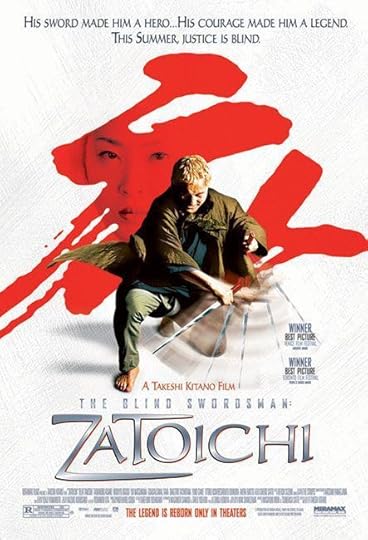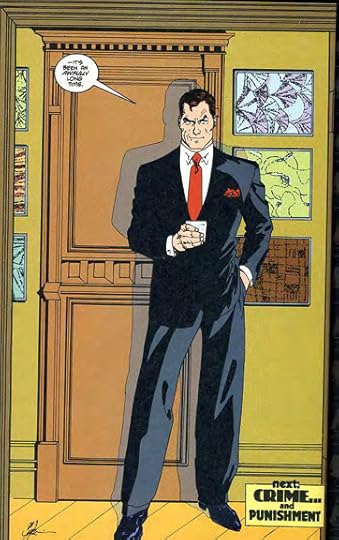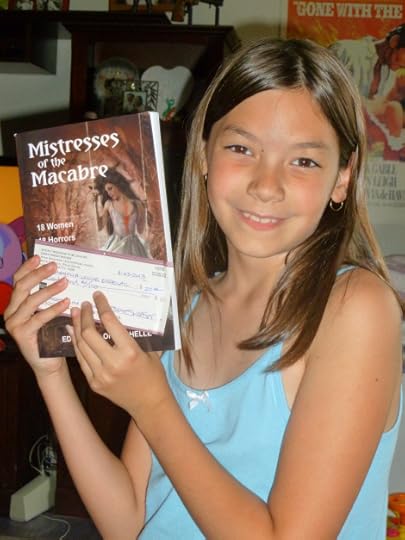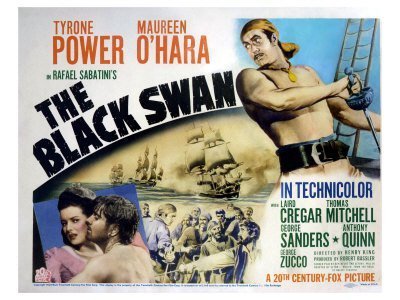Edward M. Erdelac's Blog, page 28
June 7, 2013
13 Questions With Edward M. Erdelac
Aaron Duenas, a contributor to the fantastic movie aficionado group and podcast The Gentlemen’s Guide To Midnight Cinema, had me on his Death Rattle blog for thirteen questions. So if you wanna know about my movie watching and gaming habits, as well as whose faces I’d put on my own personal Mt. Rushmore, go give it a look.
http://www.thedeathrattle.net/2013/06/13-questions-edward-m-erdelac.html


June 4, 2013
DT Moviehouse Review: The Blind Swordsman: Zatoichi
Time once more for my blog feature, DT Moviehouse Reviews, in which I make my way alphabetically through my 200+ DVD/Blu-Ray collection (you can see the list right here) and decide if each one was worth the money. Today I review Takeshi Kitano’s remake/reboot of the classic 60′s chanbara series, The Blind Swordsman: Zatoichi.
(2003) Written and Directed by Takeshi Kitano
Tagline:
His sword made him a hero. His courage made him a legend. This summer, justice is blind.
What It’s About:
 In Tokugawa-era Japan, blind, wandering masseur and master swordsman Zatoichi (Takeshi Kitano) takes up with a lone farmer, O-ume (Michiyo Okusu) and her gambling nephew Shinkichi (Gadarukanaru Taka), who live at the outskirts of a town in the midst of a conflict between opposing yakuza factions fighting for control of the gambling racket. At the same time, the Naruto siblings, one a geisha, Okinu (Yuko Daike), the other an onnagata Osei/Seitaro (Daigoro Tachibana, a real-life, classically trained Japanese onnagate, or female impersonator, actor, and recording artist), who are seeking to avenge themselves on the murderers of their parents, a gang of bandits including Boss Ogi (Saburo Ishikura) and Boss Ginzo (Ittoku Kishibi), two of the local yakuza oyabun. When another expert swordsman, yojimbo Hattori Gennosuke (Tadanobu Asano), who takes muscle jobs to support his ailing wife (Yui Natsukawa), sings on with the yakuza, it becomes inevitable that he and Zatoichi will cross swords.
In Tokugawa-era Japan, blind, wandering masseur and master swordsman Zatoichi (Takeshi Kitano) takes up with a lone farmer, O-ume (Michiyo Okusu) and her gambling nephew Shinkichi (Gadarukanaru Taka), who live at the outskirts of a town in the midst of a conflict between opposing yakuza factions fighting for control of the gambling racket. At the same time, the Naruto siblings, one a geisha, Okinu (Yuko Daike), the other an onnagata Osei/Seitaro (Daigoro Tachibana, a real-life, classically trained Japanese onnagate, or female impersonator, actor, and recording artist), who are seeking to avenge themselves on the murderers of their parents, a gang of bandits including Boss Ogi (Saburo Ishikura) and Boss Ginzo (Ittoku Kishibi), two of the local yakuza oyabun. When another expert swordsman, yojimbo Hattori Gennosuke (Tadanobu Asano), who takes muscle jobs to support his ailing wife (Yui Natsukawa), sings on with the yakuza, it becomes inevitable that he and Zatoichi will cross swords.
Why I Bought It:
I’m a tremendous chanbara fan and have had an interest in Japanese samurai culture since I got into Kazuo Koike and Goseki Kojima’s epic feudal manga Lone Wolf And Cub (Kozure Okami) somewhere around eighth grade, which led me to the films of Akira Kurosawa and Toshiro Mifune, and later Tatsuya Nakadai and Masaki Kobayashi. I first encountered “Beat” Takeshi in Kikujiro, a charming road movie that played at the Music Box Theatre in Chicago when I worked as an assistant manager.
So when I saw the first trailers for the platinum blonde haired Takeshi whipping the blood off a samurai sword in the rain, I was raring to go.
I only have a little experience with the original Zatoichi series from the sixties. I think I saw the first one, and the big crossover between Shintaro Katsu (the original Zatoichi) and Toshiro Mifune’s Sanjuro character, Zatoichi Meets Yojimbo, so I went into this 2003 reboot/remake without any preconceived notions and loved it.
 The dominant blue and red colors (of cotton, rain, and blood) are striking, and the action fast and bloody. Takeshi is an arresting physical presence whenever he’s on screen, disarmingly odd looking and goofy, yet clearly apt and deadly when he draws his sword. Maybe it’s the hair or the red cane sword, but your eyes go right to him. And yet, he’s not really ominipresent, nor even the driving character of the plot. I admit in this last viewing I was a little put off by the CGI blood and swords, which is just a little too bright and unreal, even a shade brighter than Hammer Studios blood. Most of the time I think the action was played out with sword hilts, the blades added later along with the blood spatter. It’s an interesting technique that I don’t think bothered me overly in the theater but perhaps doesn’t translate as well in HD home video.
The dominant blue and red colors (of cotton, rain, and blood) are striking, and the action fast and bloody. Takeshi is an arresting physical presence whenever he’s on screen, disarmingly odd looking and goofy, yet clearly apt and deadly when he draws his sword. Maybe it’s the hair or the red cane sword, but your eyes go right to him. And yet, he’s not really ominipresent, nor even the driving character of the plot. I admit in this last viewing I was a little put off by the CGI blood and swords, which is just a little too bright and unreal, even a shade brighter than Hammer Studios blood. Most of the time I think the action was played out with sword hilts, the blades added later along with the blood spatter. It’s an interesting technique that I don’t think bothered me overly in the theater but perhaps doesn’t translate as well in HD home video.
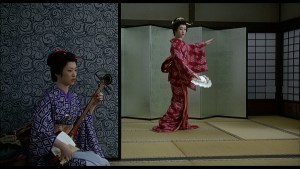 While the action is great, with Zatoichi only a sideline character, the real strength of Blind Swordsman Zatoichi is in its supporting characters, particularly the two Naruto siblings, whose tragic backstory (the boy has been forced by their poverty to resort first to a life of prostitution and then to living as a female impersonator) is revealed as the story progresses. The two actors really sell it, particularly in a positively heartbreaking scene where, as Osei dances, Okinu plays the shamisen and reminisces about their hardships, including the first time Osei sold himself to a man for money to survive. Okinu watches Osei dance, and the scene match cuts between Osei’s performance in the present, and as a young boy, face painted and in a kimono. Okinu’s performance falters, causing Osei to ask if she’s alright. The camera meanwhile pans past Aunt O-ume, who is staring at Osei with a look of intense sadness, and finally rests on Shinkichi, who is stifling his own weeping.
While the action is great, with Zatoichi only a sideline character, the real strength of Blind Swordsman Zatoichi is in its supporting characters, particularly the two Naruto siblings, whose tragic backstory (the boy has been forced by their poverty to resort first to a life of prostitution and then to living as a female impersonator) is revealed as the story progresses. The two actors really sell it, particularly in a positively heartbreaking scene where, as Osei dances, Okinu plays the shamisen and reminisces about their hardships, including the first time Osei sold himself to a man for money to survive. Okinu watches Osei dance, and the scene match cuts between Osei’s performance in the present, and as a young boy, face painted and in a kimono. Okinu’s performance falters, causing Osei to ask if she’s alright. The camera meanwhile pans past Aunt O-ume, who is staring at Osei with a look of intense sadness, and finally rests on Shinkichi, who is stifling his own weeping.
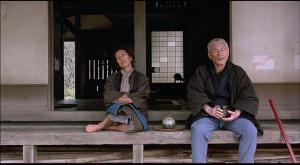 Humor is used very effectively too, from the very first meeting between Zatoichi and O-ume. When they first meet, O-ume asks Zatoichi if he has a place to stay the night, and he elicits this kind of knowing half grin which she quickly shoots down with a not gonna happen kind of comment. In the very next scene, we hear O-ume moaning, Zatoichi grunting, and the camera tilts down to show Zatoichi apparently hunched over her, moving rhythmically, remarking that she’s ‘too tight’ etc. With a subtle camera movement, it’s revealed that he’s earning his keep by plying his trade as a masseur, nothing more.
Humor is used very effectively too, from the very first meeting between Zatoichi and O-ume. When they first meet, O-ume asks Zatoichi if he has a place to stay the night, and he elicits this kind of knowing half grin which she quickly shoots down with a not gonna happen kind of comment. In the very next scene, we hear O-ume moaning, Zatoichi grunting, and the camera tilts down to show Zatoichi apparently hunched over her, moving rhythmically, remarking that she’s ‘too tight’ etc. With a subtle camera movement, it’s revealed that he’s earning his keep by plying his trade as a masseur, nothing more.
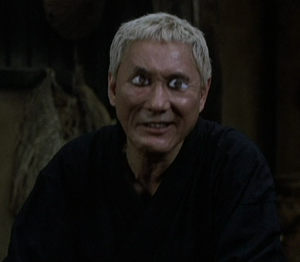 There are other pretty hilarious scenes, from swordsmen blundering into cutting each other up when facing Zatoichi, to Shinkichi’s failed attempts at mimicking the masseuse’s apparently superhuman gambling skill, and spackling his face with geisha makeup after bemoaning that he “wants to be beautiful like Osei.” There’s a kind of overweight village idiot that dresses up in bushi armor and charges around and around with a spear, yelling like Teddy Brewster in Arsenic And Old Lace.
There are other pretty hilarious scenes, from swordsmen blundering into cutting each other up when facing Zatoichi, to Shinkichi’s failed attempts at mimicking the masseuse’s apparently superhuman gambling skill, and spackling his face with geisha makeup after bemoaning that he “wants to be beautiful like Osei.” There’s a kind of overweight village idiot that dresses up in bushi armor and charges around and around with a spear, yelling like Teddy Brewster in Arsenic And Old Lace.
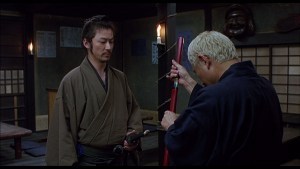 The main plot with the yakuza is admittedly a little thick, particularly after the showdown between Zatoichi and the bodyguard, which is precipitated when the two geishas try to make their move to wipe out their enemies and they are betrayed, forcing the blind man to come to their rescue. Zatoichi sets out to kill the mysterious bosses, who have been masquerading as innocuous innkeepers. There is a bit of strangeness where Zatoichi’s actual blindness comes into question. Has he been pretending he’s blind the entire time to put his enemies off guard? Has he merely trained himself to fight blind? His eyes, when he opens them are unnaturally bright, possibly cataracts. So was it a (pardon the pun) double blind? Is he a blind man who pretends to see when he faces the big boss? He certainly fights better in the dark, but there’s no definite answer.
The main plot with the yakuza is admittedly a little thick, particularly after the showdown between Zatoichi and the bodyguard, which is precipitated when the two geishas try to make their move to wipe out their enemies and they are betrayed, forcing the blind man to come to their rescue. Zatoichi sets out to kill the mysterious bosses, who have been masquerading as innocuous innkeepers. There is a bit of strangeness where Zatoichi’s actual blindness comes into question. Has he been pretending he’s blind the entire time to put his enemies off guard? Has he merely trained himself to fight blind? His eyes, when he opens them are unnaturally bright, possibly cataracts. So was it a (pardon the pun) double blind? Is he a blind man who pretends to see when he faces the big boss? He certainly fights better in the dark, but there’s no definite answer.
The whole thing ends with a Bollywood style dance number.
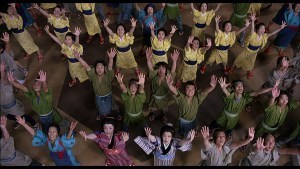 Yeah, seriously. The whole supporting cast (surviving anyway) lines up smiling and performs a toe tapping percussion-style line dance in which even the two child actors who played the geisha and the onnagata as kids get a curtain call by digitially morphing seamlessly back and forth. It sounds ridiculous, but it really is pretty cool. I’d liken it to the musical sequence at the end of Slumdog Millionaire.
Yeah, seriously. The whole supporting cast (surviving anyway) lines up smiling and performs a toe tapping percussion-style line dance in which even the two child actors who played the geisha and the onnagata as kids get a curtain call by digitially morphing seamlessly back and forth. It sounds ridiculous, but it really is pretty cool. I’d liken it to the musical sequence at the end of Slumdog Millionaire.
Percussion rhythm music shows up in the score a few times, with the shuffling of rice patty farmers, the spattering of rain on a paper umbrella, and the knocking of carpenter’s hammers and saws coming together into fascinating musical interludes.
Best Dialogue/Line:
When Aunt O-ume and Zatoichi first meet, the masseur carries her vegetables for her back to the farmhouse.
She says, “This must be quite a sight. I’m guiding a masseur, who’s carrying my vegetables.”
To which Zatoichi replies, “Wish I could see it.”
Best Scene:
For me, the first time Zatoichi really cuts loose at the gambling parlor. After taking the house for a ride more than a few times, the yakuza decide to cheat the blind man and switch the dice Zatoichi’s been betting on all this time.
“Objections?” the dice roller asks, after slapping the cup down.
“Hey,” says Zatoichi, “the dice don’t sound the same.”
One of the yakuza utters an insult, and without any further discussion, Zatoichi whips out his blade and takes the dice roller’s arm off at the elbow. The next three swipes takes out the candles lighting the room, and then all hell breaks loose, with silver arcs flashing in the moonlight, slicing open shirts and bisecting the gamblers’ intricate tattoos.
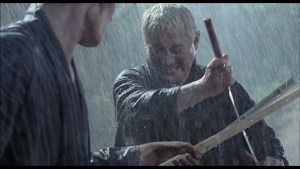 Would I Buy It Again? It’s a bit of a tough call. For all my praise of it, the CGI bloodletting did put me off this go around, and I found the main Yakuza story to be muddled, the whole thing a bit episodic. I think I would. It’s a good modern day samurai flick, but it’s no 13 Assassins.
Would I Buy It Again? It’s a bit of a tough call. For all my praise of it, the CGI bloodletting did put me off this go around, and I found the main Yakuza story to be muddled, the whole thing a bit episodic. I think I would. It’s a good modern day samurai flick, but it’s no 13 Assassins.
Next In The Queue:


May 20, 2013
DT Back Issues: The Shadow (Chaykin/Helfer)
1983-1995 (the Copper Age) was the height of my comic book collecting, and a great time to discover the medium. Starting with Larry Hama’s GI JOE: A REAL AMERICAN HERO for Marvel and gradually segueing into TRANSFORMERS and GROO THE WANDERER, I started frequenting comic shops and began to pick up anything that caught my eye. The mid 80′s saw the release, in rapid succession, of Frank Miller’s WOLVERINE (with Chris Claremont), DARK KNIGHT RETURNS, Alan Moore’s V FOR VENDETTA, THE WATCHMEN, and THE KILLING JOKE, and other positively seminal works in the field.
But I don’t wanna talk about them. I’m by no means a scholar or expert. I got out of comics for the most part when I started college, only popping in now and then since to pick up the occasional trade collection, LEAGUE OF EXTRAORDINARY GENTLEMEN, SIN CITY, THE WALKING DEAD, a couple CAPTAIN AMERICAs, THE ULTIMATES, stuff like that. All those books have been written up and dissected by far more qualified people than me, and you can look them up anywhere on the internet.
I’ve decided I’d like to revisit comics I’ve kept in the long white boxes in the back of my closet, titles that for whatever reason may not have been the most popular, and indeed, were likely forgotten for the most part, or mostly went underappreciated. I don’t know that I’m talking about rarities, or anything. I wasn’t really an underground comics guy. I’m talking more about mainstream gold that for whatever reason floated off down the creek. Stuff like THE LAST AMERICAN, MARSHAL LAW, Steve Gerber’s FOOLKILLER miniseries from the 90’s, John Wagner’s BUTTON MAN, and Evan Dorkin’s MILK AND CHEESE.
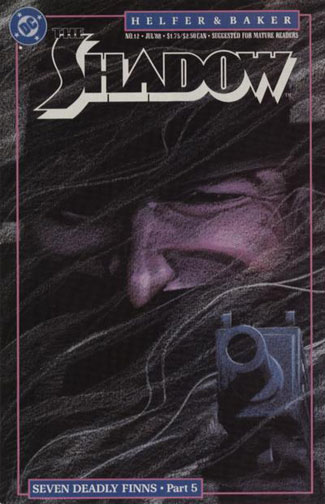 This week I’m taking a look at one of my all time favorite comic runs, the 80’s DC revamp of THE SHADOW that began with Howard Chaykin’s four-issue BLOOD & JUDGEMENT miniseries and was picked up in a glorious but achingly short lived monthly run by writer Andy Helfer that saw art by Bill Sienkiewicz, Marshall Rogers, and the auspicious debut of Kyle Baker.
This week I’m taking a look at one of my all time favorite comic runs, the 80’s DC revamp of THE SHADOW that began with Howard Chaykin’s four-issue BLOOD & JUDGEMENT miniseries and was picked up in a glorious but achingly short lived monthly run by writer Andy Helfer that saw art by Bill Sienkiewicz, Marshall Rogers, and the auspicious debut of Kyle Baker.
The Shadow had a long history as first the disembodied, sinister voice (Frank Readick Jr.’s) of a radio announcer for Street and Smith’s Detective Story Hour, a popular pulp fiction crimefighter penned by the insanely productive Walter B. Gibson, and then back to the radio as a crime/adventure series with The Shadow voiced by Orson Welles, Bill Johnstone, Brett Morrison (where I first encountered the character on an Old Time Radio tape my dad played in his Bronco), John Archer, and Steve Cortleigh, in succession.
The premise of The Shadow is of a master manipulator, a dark and faceless avenger who plots against criminals in (you guessed it) the shadows, commanding a network of agents with various talents and connections both political and criminal. The Shadow directs his agents via codes or a central dispatcher (usually the equally mysterious “Burbank”), and influences his quarry into intricate set ups, finally dispatching them personally with a pair of matched .45’s, all the while laughing ominously. The Shadow had no real superpower other than being an expert at obfuscation, disguise, hypnosis, misdirection and stealth (understandable considering Walter Gibson was an accomplished stage magician), but the radio drama added to his arsenal, for the sake of brevity of explanation, the mystic power (learned in Tibet) to cloud men’s minds and disappear from sight.
The Shadow’s alter ego is Kent Allard, a former World War I ace and spy who faked his death and took on the persona of both The Shadow and Lamont Cranston, a wealthy playboy whom he apparently resembled.
There were a few prior comic book iterations of the character, the most successful being the Michael Kaluta illustrated series at DC, but as I said, outside of The Shadow’s Revenge, a radio episode my Dad picked up on tape at a rest stop one family vacation, my introduction to the character came with the eye grabbing cover to The Shadow #8, featuring the debut of artist Kyle Baker.
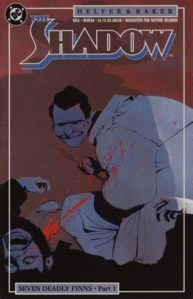 I was thirteen and browsing Friendly Frank’s Comics in Lansing, Illinois (yep, the very same Friendly Frank’s that brought about the formation of the Comic Book Legal Defense Fund) with my buddy Dave when the cover to #8 snatched my attention. Take a look at it and you can see why. This was one evocative piece of work, the kind that, as the best covers do, formulated a multitude of possible stories in my mind at a glance, the kind that just made me wanna pick this up and see what it was about. The muted blue Michael Mann-ish , coloring, instantly evoking a dark and urban feel, the mad look on the character’s face, leering back at you like a bloody-mawed lion surprised in the midst of killing a zebra (his choice of weapon, a barbeque fork, compounding the maneater impression), that gout of blood spraying out of the gasping victim’s throat, the odd, bulky proportions of the figure, and of course the looming, iconic shadow falling across it all.
I was thirteen and browsing Friendly Frank’s Comics in Lansing, Illinois (yep, the very same Friendly Frank’s that brought about the formation of the Comic Book Legal Defense Fund) with my buddy Dave when the cover to #8 snatched my attention. Take a look at it and you can see why. This was one evocative piece of work, the kind that, as the best covers do, formulated a multitude of possible stories in my mind at a glance, the kind that just made me wanna pick this up and see what it was about. The muted blue Michael Mann-ish , coloring, instantly evoking a dark and urban feel, the mad look on the character’s face, leering back at you like a bloody-mawed lion surprised in the midst of killing a zebra (his choice of weapon, a barbeque fork, compounding the maneater impression), that gout of blood spraying out of the gasping victim’s throat, the odd, bulky proportions of the figure, and of course the looming, iconic shadow falling across it all.
This was the first For Mature Readers comic I ever picked up. I was expecting full on porn and eviscerations in my heady rush back home, blood pounding in my ears, the comic sandwiched surreptitiously between my Groos and Wolverines. What I got was the first part of THE SEVEN DEADLY FINNS storyline, an alternately kick ass and at time hilarious story about the Shadow and his agents going up against the criminal enterprises of a family of brothers, the Finns, who dabble in arms dealing (via a Home Shopping Network style cable access show), drugs (smuggling narcotics in astronomically expensive and hideous children’s toys sold brazenly off the shelf to buyers in the know), prostitution, terrorism, and outright murder (one Finn brother owned a hot dog plant which he allowed his brothers to dump bodies in….memorably, a diamond stud earring in one victim makes its way into a customer’s wiener, and to salvage the situation the brother comes up with the smokescreen that the entire happening was part of a new promotional sweepstakes, in which a diamond is hid in random hot dogs. The slogan: “Every Frank A Wiener.”)
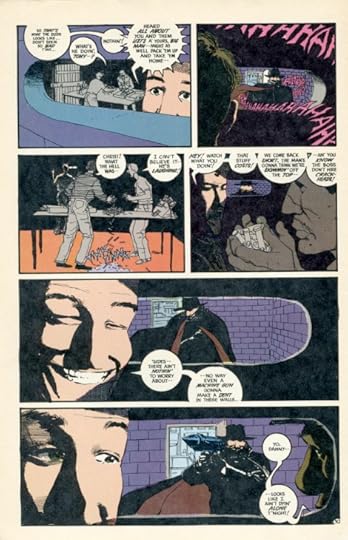 The Shadow swiftly became my favorite comic, and remains one of my favorites of all time. What attracted me about it was its focus on the well defined, brilliantly characterized agents and their perception of ‘The Master.’ There was Twitchkowitz the narcotics expert, once a pro wrestling cornerman who slipped his charges timely adrenaline injections to swing matches in their favor, DeWitt, the lowlife con man and son of a criminal informant (And I’d swear the pair of DeWitt and Twitch was copied directly by Todd McFarlane for his two cops Sam and Twitch in Spawn – right down to the character designs), Mavis, the daughter of original agent Harry Vincent, and a former federal agent, and The Shadow’s two sons, Hsu Tei and Chang, who piloted his sleek flying car (a souvenir from Shamballha, the technologically advanced Tibetan utopia where the Shadow got his training). Several of The Shadow’s old time agents had parts in the comic as well –the aforementioned Harry pursued a relationship with the Shadow’s old squeeze Margo Lane, and Burbank returned, catering to Lorelei, a paralyzed woman bound to an iron lung who was The Shadow’s new dispatcher, doubling as a phone sex operator.
The Shadow swiftly became my favorite comic, and remains one of my favorites of all time. What attracted me about it was its focus on the well defined, brilliantly characterized agents and their perception of ‘The Master.’ There was Twitchkowitz the narcotics expert, once a pro wrestling cornerman who slipped his charges timely adrenaline injections to swing matches in their favor, DeWitt, the lowlife con man and son of a criminal informant (And I’d swear the pair of DeWitt and Twitch was copied directly by Todd McFarlane for his two cops Sam and Twitch in Spawn – right down to the character designs), Mavis, the daughter of original agent Harry Vincent, and a former federal agent, and The Shadow’s two sons, Hsu Tei and Chang, who piloted his sleek flying car (a souvenir from Shamballha, the technologically advanced Tibetan utopia where the Shadow got his training). Several of The Shadow’s old time agents had parts in the comic as well –the aforementioned Harry pursued a relationship with the Shadow’s old squeeze Margo Lane, and Burbank returned, catering to Lorelei, a paralyzed woman bound to an iron lung who was The Shadow’s new dispatcher, doubling as a phone sex operator.
My enjoyment of THE SEVEN DEADLY FINNS led me to pick up the comic miniseries that had brought The Shadow into the modern era, and reinvigorated his character and origin, Howard Chaykin’s BLOOD AND JUDGEMENT. The Shadow had not learned his skills in Tibet, according to Chaykin, but in the technologically superadvanced city of Shamballha, where he had battled the real Lamont Cranston, a criminal bon vivant trying to smuggle opium out of central China in the bodies of dead missionaries. Crashlanding in Shamballha, Allard was reconstructed and trained as a paladin, a shadow warrior who could fight blind and manipulate minds. Allard took his newfound abilities, assumed the Cranston identity, and battled the underworld until the mid forties as The Shadow, when he returned to Shamballha and fathered two sons.
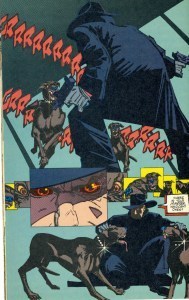 Meanwhile, the real Lamont Cranston had survived their previous encounter, and regained his fortune under the name Preston Mayrock. Eager to lure the Shadow out of hiding, Mayrock ordered the assassination of all of the Shadow’s former agents, and succeeded in horrifically murdering Clive Burke, Shrevvy, and a few others, before The Shadow returned to face him (not aged, but young as ever thanks to the advanced medicine of Shamballha).
Meanwhile, the real Lamont Cranston had survived their previous encounter, and regained his fortune under the name Preston Mayrock. Eager to lure the Shadow out of hiding, Mayrock ordered the assassination of all of the Shadow’s former agents, and succeeded in horrifically murdering Clive Burke, Shrevvy, and a few others, before The Shadow returned to face him (not aged, but young as ever thanks to the advanced medicine of Shamballha).
Chaykin’s re-imagination of the character was daring considering nobody had ever taken The Shadow out of the 30’s before. Introducing him not as an outdated fuddy duddy lost in the modern world, but a smirking, unapologetic force equal to and most often greater than any savagery the hyperkinetic punks of the 80’s could dish out, was inspired. I’m reminded of the movie Time After Time in which HG Wells pursues Jack The Ripper back to 1980’s San Francisco, and The Ripper, after sitting up all night and watching violent American culture on a television set remarks “I’m home.” The reason for The Shadow’s retirement is never given, but maybe he just got bored. Allard was an adventurer and thrillseeker who took up crimefighting not out of some moral imperative or familial tragedy, but because he just wanted to. Maybe the forties grew too tame for the master.
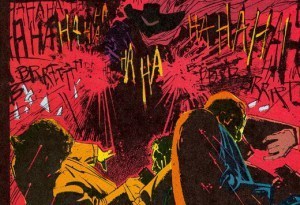 It was the success of BLOOD AND JUDGEMENT which led to the commissioning of an ongoing monthly series at DC, and the first artist to join Helfer was Bill Sienkiewicz . Now when I was a kid, jumping back from Kyle Baker’s cartoonish style to Chaykin’s realistic pulpy four color guys and dames-style figures and then Sienkiewicz, I admit I wasn’t impressed by his (what I then termed) scribbly art style. There were times I couldn’t even tell if the characters he was depicting were supposed to be human. But in revisiting Sienkiewicz’s run, I fully appreciate the artistry of what he was doing in these early issues.
It was the success of BLOOD AND JUDGEMENT which led to the commissioning of an ongoing monthly series at DC, and the first artist to join Helfer was Bill Sienkiewicz . Now when I was a kid, jumping back from Kyle Baker’s cartoonish style to Chaykin’s realistic pulpy four color guys and dames-style figures and then Sienkiewicz, I admit I wasn’t impressed by his (what I then termed) scribbly art style. There were times I couldn’t even tell if the characters he was depicting were supposed to be human. But in revisiting Sienkiewicz’s run, I fully appreciate the artistry of what he was doing in these early issues. 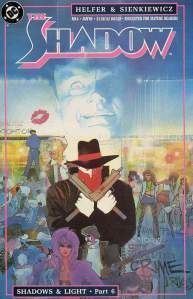 The human figures are often grotesque and bizarre looking, but always interesting. There’s a pimply computer hacker named Alfred, and Sienkiewicz depicts him in one panel pointing and wolfing down a cheeseburger as he stands ankle deep in a pile of McDonald’s cartons that turned me off of McDonald’s for a few months. I love the kinetic lines of action and reaction he inserts into their eye lines and auras, like the cartoony twitching of Popeye’s elbows. Sienkiewicz is the only guy I know that can draw a blink. He maximizes reactions.
The human figures are often grotesque and bizarre looking, but always interesting. There’s a pimply computer hacker named Alfred, and Sienkiewicz depicts him in one panel pointing and wolfing down a cheeseburger as he stands ankle deep in a pile of McDonald’s cartons that turned me off of McDonald’s for a few months. I love the kinetic lines of action and reaction he inserts into their eye lines and auras, like the cartoony twitching of Popeye’s elbows. Sienkiewicz is the only guy I know that can draw a blink. He maximizes reactions. 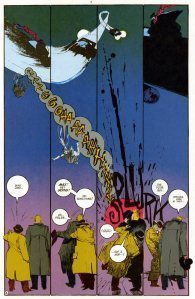 The violence in The Shadow is shocking under his hand, with a mind controlled cyclist driving his bike head on into a Mack truck in one panel seeming to explode across the grill, and characters falling from great heights to smack the pavement drawn so you can almost feel the impact yourself. And the way he draws the Shadow himself is unparalleled. When the Shadow appears to criminals with a pair of twin mini-UZI’s (or MAC-10’s, I think Sienkiewicz drew him with), he’s a terror; a nightmare figure of inky darkness and impossible angles, illuminated by rapid muzzle flashes and ensconced by swirling, mad laughter and that crazily whipping Tom Baker-length crimson scarf.
The violence in The Shadow is shocking under his hand, with a mind controlled cyclist driving his bike head on into a Mack truck in one panel seeming to explode across the grill, and characters falling from great heights to smack the pavement drawn so you can almost feel the impact yourself. And the way he draws the Shadow himself is unparalleled. When the Shadow appears to criminals with a pair of twin mini-UZI’s (or MAC-10’s, I think Sienkiewicz drew him with), he’s a terror; a nightmare figure of inky darkness and impossible angles, illuminated by rapid muzzle flashes and ensconced by swirling, mad laughter and that crazily whipping Tom Baker-length crimson scarf.
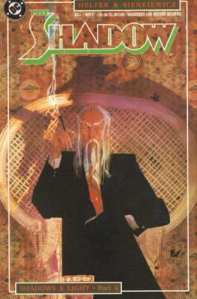 The Helfer/Sienkiewicz run gave us the return of The Golden Master, Shiwan Khan, a yellow peril villain who appeared in two of the pulp novels. Here, Khan was an aged cross between Ming The Merciless and David Lo Pan, brilliant high tech industrialist beloved by consumers for his philanthropy and good humor. But of course, Khan had ulterior motives, and had developed a method for mass mind control stolen midway through the storyline by The Light, a fanatical televangelist with mind powers rivaling the Shadow’s own. The Light’s backstory was depicted concurrently in the first Shadow annual, a lurid 40’s tale of atomic bomb worship and the failed return of the Third Reich.
The Helfer/Sienkiewicz run gave us the return of The Golden Master, Shiwan Khan, a yellow peril villain who appeared in two of the pulp novels. Here, Khan was an aged cross between Ming The Merciless and David Lo Pan, brilliant high tech industrialist beloved by consumers for his philanthropy and good humor. But of course, Khan had ulterior motives, and had developed a method for mass mind control stolen midway through the storyline by The Light, a fanatical televangelist with mind powers rivaling the Shadow’s own. The Light’s backstory was depicted concurrently in the first Shadow annual, a lurid 40’s tale of atomic bomb worship and the failed return of the Third Reich.
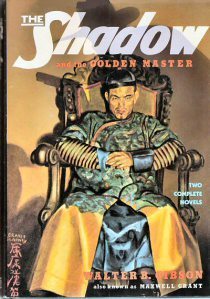 Following the Shadows & Light storyline, in issue #7 Helfer took his first stab at the black humor that would characterize the title’s final issues with the chilling and portentious one-off story HAROLD GOES TO WASHINGTON, with guest artist Marshall Rogers. In this issue, a couple of the Shadow’s agents decide to help out fellow agent Elton Butterfield, a substitute elementary school teacher, whose class has been chosen to visit Washington DC and sit in on a taping of President Reagan’s speech. As the agents go about their shenanigans of dealing with a bunch of shrill carsick youths, all the while praying the master doesn’t find out about their misuse of his manpower (inevitably he does), unbeknownst to everyone, misanthropic young Harold, whose father died in the war, has decided, in a bout of neglected and misunderstood child sociopathy, that he must be a war hero like his father. Since he has been told the President keeps the world at peace, there can never be a war. Thus, to be a war hero, he must kill the President with the German luger he steals from the trunk full of Nazi paraphernalia in the attic.
Following the Shadows & Light storyline, in issue #7 Helfer took his first stab at the black humor that would characterize the title’s final issues with the chilling and portentious one-off story HAROLD GOES TO WASHINGTON, with guest artist Marshall Rogers. In this issue, a couple of the Shadow’s agents decide to help out fellow agent Elton Butterfield, a substitute elementary school teacher, whose class has been chosen to visit Washington DC and sit in on a taping of President Reagan’s speech. As the agents go about their shenanigans of dealing with a bunch of shrill carsick youths, all the while praying the master doesn’t find out about their misuse of his manpower (inevitably he does), unbeknownst to everyone, misanthropic young Harold, whose father died in the war, has decided, in a bout of neglected and misunderstood child sociopathy, that he must be a war hero like his father. Since he has been told the President keeps the world at peace, there can never be a war. Thus, to be a war hero, he must kill the President with the German luger he steals from the trunk full of Nazi paraphernalia in the attic.
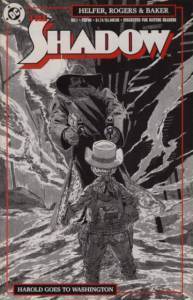 Much of the story is told from Harold’s fractured point of view, and we are privy to his everyday madness. He burns a roach motel full of trapped insects on the kitchen stove (in a scene that reminds me of the opening of THE WILD BUNCH), tests the Luger on the family cat, and, when threatened with exposure by a schoolmate, memorably traps the boy’s jacket in the window of a departing bus, killing him. I can’t stress enough the prescience of this single story, or its relevance to our modern society of school shootings and youth violence. Harold is a boy left to his own devices to figure out the world, and mainly ignored by his mother and teachers or dismissed as creepy by his peers, of course he gets it horribly wrong. Helfer penned a terrifying masterpiece in this transitional tale.
Much of the story is told from Harold’s fractured point of view, and we are privy to his everyday madness. He burns a roach motel full of trapped insects on the kitchen stove (in a scene that reminds me of the opening of THE WILD BUNCH), tests the Luger on the family cat, and, when threatened with exposure by a schoolmate, memorably traps the boy’s jacket in the window of a departing bus, killing him. I can’t stress enough the prescience of this single story, or its relevance to our modern society of school shootings and youth violence. Harold is a boy left to his own devices to figure out the world, and mainly ignored by his mother and teachers or dismissed as creepy by his peers, of course he gets it horribly wrong. Helfer penned a terrifying masterpiece in this transitional tale.
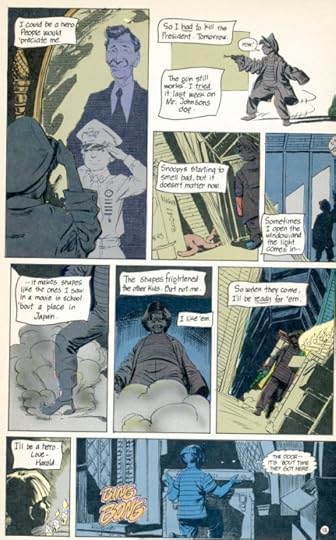 Harold goes on the field trip dressed as a cowboy (brilliantly wearing the Luger in full view of his oblivious teachers and the secret service), but misses his shot at the President, and institutes a running gun battle through some kind of huge diorama of Washington DC. I can’t begin to analyze what’s going on here, with a giant child in a cowboy outfit shooting his way through a miniature DC like some kind of crazed redneck Godzilla. Maybe Harold is an analogy for Reagan America itself. But when he’s surprised by a G-man and blows the guy’s brains point blank all over the place, he is confronted at last with the harsh reality of his fantasy, and dies not by The Shadow’s hand, but by fate’s. The Shadow shows up in time to give the deonouement, as the boy literally hangs from the obelisk of the Washington monument by his cowboy hat string, a victim of his own deluded sense of masculinity perhaps. Again, this is a comic book masterpiece. One of the most chilling and memorable issues of my youth.
Harold goes on the field trip dressed as a cowboy (brilliantly wearing the Luger in full view of his oblivious teachers and the secret service), but misses his shot at the President, and institutes a running gun battle through some kind of huge diorama of Washington DC. I can’t begin to analyze what’s going on here, with a giant child in a cowboy outfit shooting his way through a miniature DC like some kind of crazed redneck Godzilla. Maybe Harold is an analogy for Reagan America itself. But when he’s surprised by a G-man and blows the guy’s brains point blank all over the place, he is confronted at last with the harsh reality of his fantasy, and dies not by The Shadow’s hand, but by fate’s. The Shadow shows up in time to give the deonouement, as the boy literally hangs from the obelisk of the Washington monument by his cowboy hat string, a victim of his own deluded sense of masculinity perhaps. Again, this is a comic book masterpiece. One of the most chilling and memorable issues of my youth.

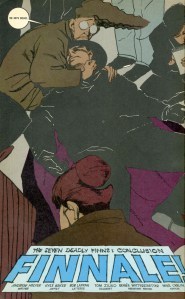 At any rate, back to THE SEVEN DEADLY FINNS, which, after a positively riveting multi-part storyline, incredibly, ends with the Shadow’s apparent death by poison gas. Yep, the very next issue, kicking off the BODY AND SOUL storyline, depicted the Shadow lying in his coffin on the cover. And he was really dead. But it’s a testament to Helfer’s writing that even with the titular character out of the picture, the supporting cast, none of them superpowered or costumed (well at first), still managed to hold my attention at age thirteen.
At any rate, back to THE SEVEN DEADLY FINNS, which, after a positively riveting multi-part storyline, incredibly, ends with the Shadow’s apparent death by poison gas. Yep, the very next issue, kicking off the BODY AND SOUL storyline, depicted the Shadow lying in his coffin on the cover. And he was really dead. But it’s a testament to Helfer’s writing that even with the titular character out of the picture, the supporting cast, none of them superpowered or costumed (well at first), still managed to hold my attention at age thirteen.
In the wake of the Shadow’s death, crime rises to an unprecedented height, culminating in the audacious high rise killings, in which a pair of chummy burglars break into well to do apartments and toss the occupant over the balcony, betting the entire haul of loot on wether or not the hapless victim lands on his head or his tails. The Shadow’s agents, depressed at the loss of their master and feeling purposeless, decide to carry out his work themselves and more, to seek out a replacement to guide their actions. At first, they try to convince another pulp hero, master of disguise Richard Benson AKA The Avenger to be their new master, but when he refuses, they decide to try and track down a new hero making a name for himself, the green skinned, green clad Inoculator, who injects his victims (child pornographers and crooked cops) with lethal doses of prescription drugs, delivered from a rifle like injector mechanism.
The only problem with this plan is the Inoculator is actually Twitchkowitz.
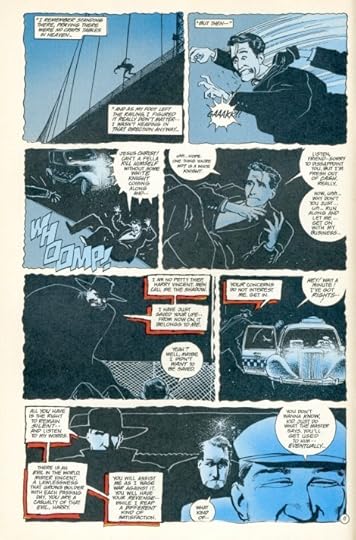 The second Shadow Annual appeared as a sideline to the ongoing series, taking time out to celebrate the character’s history with a well executed homage to the original voice of the master, Orson Welles. In this issue, Rupert, a nominal associate of the Shadow’s agents who has been trying to break into broadcast news reporting, interrupts a screening of a television retrospective documentary of the Shadow’s career. Having been present at the Shadow’s death, and having heard him mutter the word ‘Lenore,’ Rupert sets out at the behest of the ambivalent producers to learn the meaning of the Shadow’s last spoken word. He interviews Margo Lane, Harry Vincent, and Dr. Roy Tam in succession, learning how each of them came into the Shadow’s service. Harry’s story is a faithful variation of his introduction in the pulps (Harry was saved from suicide by the Shadow as depicted in Gibson’s first novel, THE LIVING SHADOW), but Roy Tam and Margo are each given cool little introductory stories of their first meetings with the Shadow – Tam, patching him up after he caught a bullet during a Chinatown shootout, and Margo, after helping to foil a plot by a Nazi agent to deliver coded messages over the airwaves during a radio drama broadcast (with Orson Welles in the sound booth). The new agents Elton, DeWitt, and Twitch, are given a humorous backstory (The Shadow, upon deciding to make Twitch his agent, delivers an impressive about how he doesn’t take just anyone into his service, and DeWitt bursts in with Elton in tow, yelling HEY MASTER I GOTTA ANUDDER ONE FOR YA!) . Each offer their own impressions of Kent Allard/The Shadow unique to their particular relationships, with Burbank’s dogged tale of loyalty over the years a particular standout. As a ham radio enthusiast, following The Shadow’s disappearance in 1940, Burbank is the only one to keep in contact with him, reading his master newspapers and keeping him up to date on the developments of the western world over the decades. The whole thing wraps up with a nice denouement worthy of its inspiration, CITIZEN KANE, as ‘Lenore’ is revealed to be something indicative of Kent Allard’s youth, which he held in very high esteem.
The second Shadow Annual appeared as a sideline to the ongoing series, taking time out to celebrate the character’s history with a well executed homage to the original voice of the master, Orson Welles. In this issue, Rupert, a nominal associate of the Shadow’s agents who has been trying to break into broadcast news reporting, interrupts a screening of a television retrospective documentary of the Shadow’s career. Having been present at the Shadow’s death, and having heard him mutter the word ‘Lenore,’ Rupert sets out at the behest of the ambivalent producers to learn the meaning of the Shadow’s last spoken word. He interviews Margo Lane, Harry Vincent, and Dr. Roy Tam in succession, learning how each of them came into the Shadow’s service. Harry’s story is a faithful variation of his introduction in the pulps (Harry was saved from suicide by the Shadow as depicted in Gibson’s first novel, THE LIVING SHADOW), but Roy Tam and Margo are each given cool little introductory stories of their first meetings with the Shadow – Tam, patching him up after he caught a bullet during a Chinatown shootout, and Margo, after helping to foil a plot by a Nazi agent to deliver coded messages over the airwaves during a radio drama broadcast (with Orson Welles in the sound booth). The new agents Elton, DeWitt, and Twitch, are given a humorous backstory (The Shadow, upon deciding to make Twitch his agent, delivers an impressive about how he doesn’t take just anyone into his service, and DeWitt bursts in with Elton in tow, yelling HEY MASTER I GOTTA ANUDDER ONE FOR YA!) . Each offer their own impressions of Kent Allard/The Shadow unique to their particular relationships, with Burbank’s dogged tale of loyalty over the years a particular standout. As a ham radio enthusiast, following The Shadow’s disappearance in 1940, Burbank is the only one to keep in contact with him, reading his master newspapers and keeping him up to date on the developments of the western world over the decades. The whole thing wraps up with a nice denouement worthy of its inspiration, CITIZEN KANE, as ‘Lenore’ is revealed to be something indicative of Kent Allard’s youth, which he held in very high esteem.
Meanwhile back in the regular series, the bid to return the Shadow to life (this is comics, after all) has already been set in motion by the Shadow’s two bumbling sons, Hsu Tei and Chang, who, having lost their father’s funerary instructions, decide to take his body back to Shamballha. This plot line swiftly spirals into a chaotic comedy of errors as the Chinese military shoots down their flying car, leaving Hsu Tei and Chang to drag their father’s corpse to a barbaric town of criminal anarchists and paramilitary survivalists known as Malice, where they befriend a gang of juvenile delinquents (the children of Malice) and are chased out of town for various infractions of the bizarre Malice penal code by both the townspeople and the murderous Arbitrator, a magnum toting judge in black robes and a powdered Parliamentary wig whose final ruling is always execution. The Shadow’s fire opal ring (and finger) are stolen by the followers of a female rockstar who apparently collects dead celebrities, the Shadow is decapitated by the blades of a plummeting helicopter, and Hsu Tei and Chang finally arrive in Shamballha with the children of Malice only to find they have led the crazed citizenry to the hidden utopia.
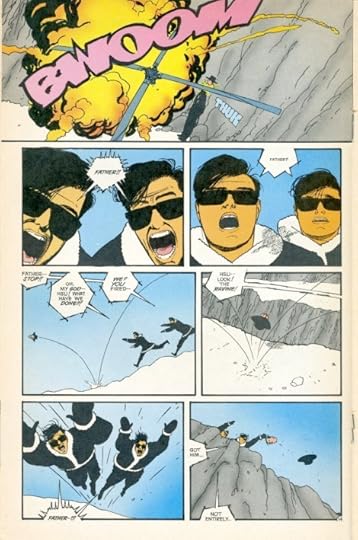 The Shadow’s head is revived and he berates his fool sons as the scientists of Shamballha grow a new body for him. The children of Malice are doled out to wanting families by the elders of Shamballha, and all seems right with the world until the tanks of Malice roll into town and begin laying waste to the pacifist populace. The Shadow opts to have his head placed on a prototype metallic body with armaments that put Robocop to shame, and he singlehandedly defends Shamballha, resolving to give the robot body a couple test drives in New York City before returning for his proper fleshy form.
The Shadow’s head is revived and he berates his fool sons as the scientists of Shamballha grow a new body for him. The children of Malice are doled out to wanting families by the elders of Shamballha, and all seems right with the world until the tanks of Malice roll into town and begin laying waste to the pacifist populace. The Shadow opts to have his head placed on a prototype metallic body with armaments that put Robocop to shame, and he singlehandedly defends Shamballha, resolving to give the robot body a couple test drives in New York City before returning for his proper fleshy form.
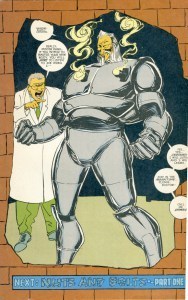 On the last page of the last issue, we learn that Shiwan Khan, crippled way back in issue #6, has had his own head put on a similar robot body by renegade Shamballhan doctors, and the splash page card promises the next issue will kick off the NUTS AND BOLTS storyline.
On the last page of the last issue, we learn that Shiwan Khan, crippled way back in issue #6, has had his own head put on a similar robot body by renegade Shamballhan doctors, and the splash page card promises the next issue will kick off the NUTS AND BOLTS storyline.
But it never happened.
There are various stories as to why The Shadow was cancelled. Likely it was a lack of sales, but it may be due to the intervention of Conde Nast, the rights holders of The Shadow property, who apparently realized too late the quirky turn the comic had taken and took exception. Whatever happened, The Shadow ceased to be, making it the second great unfinished comic tale of my youth (the first was LONE WOLF AND CUB, which I had the original American First Comics printings of, but ten years after that company went under, Dark Horse thankfully reprinted the whole thing from beginning to end).
Scrambling to hold onto the rights, DC replaced the modern day Shadow with a series set in the classic 1930’s era, called THE SHADOW STRIKES. I picked up the first issue, but it was pretty standard derring do fare, nothing more than an illustrated pulp, really, and anyway, it couldn’t alleviate my disappointment in the series I loved being cancelled mid-story. I think this was the first such disappointment in my life. I remembered thinking how fantastic the plot was and being thunderstruck that something so good could just get the rug pulled out from under it. The character felt very real to me, and it seemed impossible that I would never learn what happened to Twitch, Mavis, DeWitt, or any of them.
But I never would.
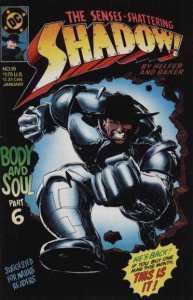 What the heck was Helfer doing in these last few issues? He displayed such a brilliant knack for characterization that I can’t imagine this robotization of the Shadow was just a stunt to bring in more readers. Was he undertaking some crazy absurdist experiment under the noses of his editors? Is that even possible? Had he learned Conde Nast was cracking down on him for his darkly humorous portrayal and decided to give them a big middle finger as he went out?
What the heck was Helfer doing in these last few issues? He displayed such a brilliant knack for characterization that I can’t imagine this robotization of the Shadow was just a stunt to bring in more readers. Was he undertaking some crazy absurdist experiment under the noses of his editors? Is that even possible? Had he learned Conde Nast was cracking down on him for his darkly humorous portrayal and decided to give them a big middle finger as he went out?
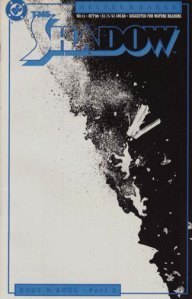 Look at the cover for the final, silly and brutish issue of the Shadow, #19. It’s typical comic book fare. The Shadow, still wearing his slouch hat, has this clobberin’ time look on his face as he smashes through a wall. The titles, in Indiana Jones style , as with rivets reads THE SENSES SHATTERING SHADOW! and the print on the cover is haphazard and funnybook-y, as it hadn’t been through the entire run ever. It looks ridiculous in context, but put the Hulk in that picture or the Thing or any other four color juvenile hero and you’ll realize it’s pretty standard issue. Were Baker and Helfer saying, OK here you go – here’s what you wanted? The Shadow for kids?
Look at the cover for the final, silly and brutish issue of the Shadow, #19. It’s typical comic book fare. The Shadow, still wearing his slouch hat, has this clobberin’ time look on his face as he smashes through a wall. The titles, in Indiana Jones style , as with rivets reads THE SENSES SHATTERING SHADOW! and the print on the cover is haphazard and funnybook-y, as it hadn’t been through the entire run ever. It looks ridiculous in context, but put the Hulk in that picture or the Thing or any other four color juvenile hero and you’ll realize it’s pretty standard issue. Were Baker and Helfer saying, OK here you go – here’s what you wanted? The Shadow for kids?
Look at the abstract artistry Baker did for the cover of #15 only four issues prior, depicting the corpse of the Shadow falling down a snowy mountainside with his two idiot sons.
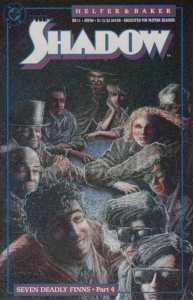 Look at the reverence with which he recreated the cover of the original pulp novel THE LONE TIGER featuring The Shadow’s agents for #11, putting in the aged Burbank and Harry and substituting the new agents for those that had been lost.
Look at the reverence with which he recreated the cover of the original pulp novel THE LONE TIGER featuring The Shadow’s agents for #11, putting in the aged Burbank and Harry and substituting the new agents for those that had been lost.  These guys were taking their job seriously, and displayed (to say nothing of the brilliant multi-layered references of the Shadow Annual #2), I think, a respect for the character and his origins as well as a commitment to taking him interesting places he’d never been before.
These guys were taking their job seriously, and displayed (to say nothing of the brilliant multi-layered references of the Shadow Annual #2), I think, a respect for the character and his origins as well as a commitment to taking him interesting places he’d never been before.
The robo-Shadow thing….yeah, it reads silly. But you know what? In the heat of the story, I was along for the ride. I would’ve gone almost anywhere Helfer and Baker took me. That’s good comics. Good writing, no matter the medium.
With the advent of the internet I read into the fate of Helfer’s Shadow, and came to be baffled by the slew of negative feelings from professed Shadow fans for this incarnation. Apparently the series is practically anathema to the majority of hardcore Shadow aficionados, who seem to prefer the character remain strictly in the original pulp era, and yet bemoan the lack of exposure for their favorite character in TV and movies.
But how can a hero character capture the public imagination if he’s not allowed to evolve with the times? The gun toting, Catwoman spanking Batman of the 1940′s bears little resemblance to the Batman of today, just as the absurdist Batman movie of the 1960′s is not the Dark Knight that broke box office records (or even the surreal circus-like Batman of the 80′s which did the same).
And the Shadow is the inspiration for Batman.
Recently, Chaykin’s BLOOD AND JUDGEMENT was re-released by Dynamite, and he was interviewed about the project by Comic Book Resources. Of choosing to bring the character into modern day, he said;
“[I felt] that the reason the character had been identified with that period through that point was because it had been cancelled in 1949. To support that idea based on its failure seemed kind of counter intuitive. My feeling is that if Batman had been cancelled in 1945, he too would be perceived as a period character. So I thought it was important to figure out a way to do the character in a contemporary setting and a contemporary format.”
Further, he addressed the backlash of the character’s fan base;
“Comic book fandom is evenly divided between people who like comics in a general way and are fans of comics in general, and then there’s an entire spade of juvenilists who attach themselves to the old joke about the Golden Age of comics. ‘What’s the Golden Age of comics? 12!’ There’s this tremendous idea that their tastes were formed and refined at 12, and frankly, I’m not interested in supporting that sensibility. By the same token, if I’m going to be doing a mature readers product, I don’t feel the need to stand by the standards of a 12-year-old sensibility.”
I’m inclined to agree. I liken the phenomenon of the Shadow and his more rigid fans to an indie band and its devoted followers who have been there with them since they cut their first album. Struggling for years in relative obscurity, the band finally hits it big. Suddenly, everybody’s humming their tunes, and they’re playing Lollapalooza or whatever. And to the old school fans, all of a sudden they suck, and everything they do sounds like crap. They’re not being true to their roots and playing the same old comfortable tune.
But playing it safe and repeating their tunes isn’t what made them hit it big.
I just don’t get that mentality.
The Shadow is a great, iconic character, yes, and these comics were the gateway to the original pulps for me, and the radio shows. I now appreciate the character in all three incarnations. But I really don’t believe he needs to be bound to the pulp era. The Lone Ranger is one of the few characters I can call to mind that can’t exist outside of his original time period, and that’s because he’s a Texas Ranger on a white horse with Colt revolvers and an Indian companion.
There’s no reason for the Shadow to remain in the past.
Chaykin and Helfer did an amazing job of bringing the Shadow character into the present, and it’s the kind of injustice worthy of the barking of the master’s forty fives that this title’s gotten such flack.
Why this book continues to remain in obscurity, why it was never allowed to run its course….
Only the Shadow knows.


May 17, 2013
Come Up And See Me Sometime (At Mysterious Galaxies In Redondo Beach This Sunday)
This Sunday from 2:30pm to 3:30pm I’ll be Mysterious Galaxies Bookstore in Redondo Beach signing copies of Eric Guignard’s AFTER DEATH anthology, in which my story SEA OF TREES appears.
I’ll be practicing signing my name and trying to keep the uhs and ums out of my speech during a Q&A as well, alongside fellow contributors Lisa Morton, Kelly Dunn, Benjamin Kane Ethridge, John Palisano, Brad Hodson, and artist Audra Phillips, as well as the author of ANGEL FALLS, Michael Paul Gonzalez.
Check out the link for details and directions -
http://www.mystgalaxy.com/Event/A-Deadly-Afternoon-RB-051913


May 11, 2013
My Daughter Magnolia’s Story “Moths” Appearing In Mistresses Of The Macabre
A bit of nepotism now (gimme a break though, she’s eight). My daughter Magnolia’s second published story is currently appearing in Mistresses of The Macabre, an all-female horror anthology from Dark Moon Books.
It’s called “Moths” and is about a troop of camping kids and their two chaperones coming across something monstrous in the depths of the Sequoyah Forest.
Give it a look – http://www.amazon.com/Mistresses-Macabre-Lori-Michelle/dp/0988556952/ref=sr_1_1?ie=UTF8&qid=1368293219&sr=8-1&keywords=mistresses+of+the+


May 10, 2013
DT Moviehouse Review: Blade
Time once more for my blog feature, DT Moviehouse Reviews, in which I make my way alphabetically through my 200+ DVD/Blu-Ray collection (you can see the list right here) and decide if each one was worth the money. Today I review Marvel’s first ever comic book movie hit, Blade.
(1998) Directed by Stephen Norrington
Screenplay by David S. Goyer
Tagline:
The power of an immortal. The soul of a human. The heart of a hero.
What It’s About:
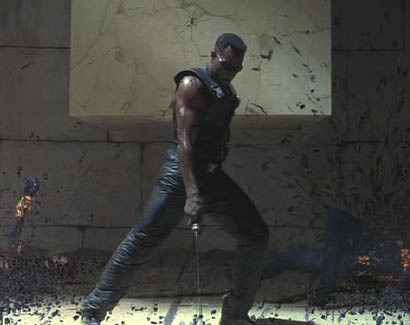 “You better wake up! The world you live in is just a sugar coated topping. There is another world beneath it – the real world.” In the real world, immortal vampires enjoy a parasitic relationship with mortal man, controlling the population through their puppet police force and world governments. Standing against the bloodsuckers is Eric “Blade” Brooks (Wesley Snipes). After his mother was attacked by a vampire while he was in the womb, Blade was born with superhuman vampiric abilities, but none of the selfsame weaknesses, aside from a growing hunger to consume blood, which he suppresses with the help of his grizzled partner, weapons designer and serum synthesizer, Whistler (Kris Kristofferson). When Deacon Frost (Stephen Dorf) an ambitious young vampire revolutionary, sets out to overthrow the elder hierarchy and call up La Magra, an ancient vampire deity to throw back the curtain and rule humanity outright, Blade enlists the help of Dr. Karen Jensen (N’Bushe Wright), a blood expert unwillingly thrust into the action.
“You better wake up! The world you live in is just a sugar coated topping. There is another world beneath it – the real world.” In the real world, immortal vampires enjoy a parasitic relationship with mortal man, controlling the population through their puppet police force and world governments. Standing against the bloodsuckers is Eric “Blade” Brooks (Wesley Snipes). After his mother was attacked by a vampire while he was in the womb, Blade was born with superhuman vampiric abilities, but none of the selfsame weaknesses, aside from a growing hunger to consume blood, which he suppresses with the help of his grizzled partner, weapons designer and serum synthesizer, Whistler (Kris Kristofferson). When Deacon Frost (Stephen Dorf) an ambitious young vampire revolutionary, sets out to overthrow the elder hierarchy and call up La Magra, an ancient vampire deity to throw back the curtain and rule humanity outright, Blade enlists the help of Dr. Karen Jensen (N’Bushe Wright), a blood expert unwillingly thrust into the action.
Why I Bought It:
It’s fitting that the first comic book movie to show up on the review list is Blade. Without the success of Blade, there would be no Spider-Man, no X-Men, no Iron Man, no Avengers franchises.
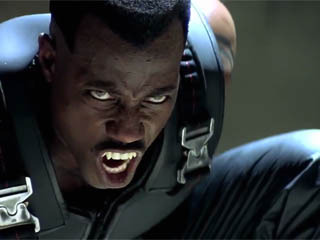 Blade was Marvel’s first big hit. The first of its characters to successfully transition to the big screen and the first Marvel film to earn a theatrical release. Prior attempts at getting Captain America, The Fantastic Four, and The Punisher to audiences resulted in direct to video US releases, mainly forgettable.
Blade was Marvel’s first big hit. The first of its characters to successfully transition to the big screen and the first Marvel film to earn a theatrical release. Prior attempts at getting Captain America, The Fantastic Four, and The Punisher to audiences resulted in direct to video US releases, mainly forgettable.
What’s so unlikely, is that Marvel took an obscure character from the 70’s (Blade was created by Gene Colan and Marv Wolfman to be part of the crew that hunts Dracula in the Tomb of Dracula title), made him a headliner in an R-rated action horror movie, and came away with a pretty sizable success. This wasn’t Spider-Man or The Punisher, this was Blade. Blade! It’s like making a Robin movie without ever having a Batman flick, or putting out a picture about The Wonder Twins.
OK, not that unlikely, but pretty unlikely.
But Blade, despite all its got going against it, remains one of the coolest comic book movies of all time.
Every time I rewatch Blade I’m giddy with how much I still enjoy it. I didn’t see it in the theater. It looked like a rental to me. But it grabs you right from the beginning with its super rain slicked visuals and frenetic Hong Kong style action, its nifty CGI (I was really wowed by the disintegrating vampires when I first caught this) and driving, ultra-cool soundtrack.
 Wesley Snipes looks like he’s having a great time in this one. Before Blade, I only knew him from Jungle Fever, Sugar Hill, Mo Better Blues, and New Jack City, and even though I was aware of Passenger 57, I thought it was a bump in the road in the career of a mainly serious actor. But watching this, I can see Snipes’ fondness for this role in his performance, a barely contained nerdiness that escapes now and then in his impromptu fist pumps and certain comic book-y expressions. Blade is an extremely physical role. He barely has any lines, but he arrests your attention whenever he’s on screen.
Wesley Snipes looks like he’s having a great time in this one. Before Blade, I only knew him from Jungle Fever, Sugar Hill, Mo Better Blues, and New Jack City, and even though I was aware of Passenger 57, I thought it was a bump in the road in the career of a mainly serious actor. But watching this, I can see Snipes’ fondness for this role in his performance, a barely contained nerdiness that escapes now and then in his impromptu fist pumps and certain comic book-y expressions. Blade is an extremely physical role. He barely has any lines, but he arrests your attention whenever he’s on screen.
 I can picture Snipes as a wide-eyed kid haunting Chinese video stores for those awesome blurry videos with the barely readable white subtitles and the too large clamshell cases in a carefully ironed coolie shirt. The guy loves kung fu movies, loves martial arts (became a practitioner at age 12), and it shows in his performance, in the little physical homages he does. Several of Blade’s dismissive, sort of “bitch, please” expressions remind me of Bruce Lee, and there are moments during the fight sequences where I see Jackie Chan in his reactions, Jet Li, Jim Kelly and the Run Run Shaw gang in his stances and poses. I read somewhere that it was Snipes’ great ambition to star in a movie with Jackie Chan, and I wish now he’d got his chance. I’ll bet he was ready to roundhouse kick his TV over when the Rush Hour movies were announced.
I can picture Snipes as a wide-eyed kid haunting Chinese video stores for those awesome blurry videos with the barely readable white subtitles and the too large clamshell cases in a carefully ironed coolie shirt. The guy loves kung fu movies, loves martial arts (became a practitioner at age 12), and it shows in his performance, in the little physical homages he does. Several of Blade’s dismissive, sort of “bitch, please” expressions remind me of Bruce Lee, and there are moments during the fight sequences where I see Jackie Chan in his reactions, Jet Li, Jim Kelly and the Run Run Shaw gang in his stances and poses. I read somewhere that it was Snipes’ great ambition to star in a movie with Jackie Chan, and I wish now he’d got his chance. I’ll bet he was ready to roundhouse kick his TV over when the Rush Hour movies were announced.
Add to that the fact that Snipes is breaking ground portraying the world’s first cinematic African American superhero (Spawn doesn’t count for me – he was masked most of the time, and please don’t try to bring up Meteor Man), and yeah, there’s a barely perceptible but definite kid in a candy store vibe to Snipes in Blade.
 But make no mistake, Blade is a total badass, so monumentally skilled and high powered that his swagger is totally deserved (“Quinn. I’m gettin’ real tired of cuttin’ you up.”), and instead of dropping a lot of dumb one-liners, when the chips are down, he speaks with his actions. I love the scene where Quinn (Donal Logue), wearing Blade’s sunglasses, giddily announces the latest regrowth of his hand (Blade has chopped them both off at various times) and dances in place with a knife. “I got two new hands, Blade, and I don’t know which one I’m gonna kill you with!” He lunges forward and Blade’s only answer is to spin, neatly decapitating him with a length of concealed razor wire, and reclaim his sunglasses as they fall. Maybe there’s something of the alternate definition of blade in his name, that of the dashing youth with implied panache and style, I don’t know – but he’s got it in spades.
But make no mistake, Blade is a total badass, so monumentally skilled and high powered that his swagger is totally deserved (“Quinn. I’m gettin’ real tired of cuttin’ you up.”), and instead of dropping a lot of dumb one-liners, when the chips are down, he speaks with his actions. I love the scene where Quinn (Donal Logue), wearing Blade’s sunglasses, giddily announces the latest regrowth of his hand (Blade has chopped them both off at various times) and dances in place with a knife. “I got two new hands, Blade, and I don’t know which one I’m gonna kill you with!” He lunges forward and Blade’s only answer is to spin, neatly decapitating him with a length of concealed razor wire, and reclaim his sunglasses as they fall. Maybe there’s something of the alternate definition of blade in his name, that of the dashing youth with implied panache and style, I don’t know – but he’s got it in spades.  The ending is off the chain ridiculous, with Blade performing several unbelievably timed and executed tricks, throwing his booby trapped sword into a stone crack, catching the coagulant stuff behind his back, and not being content to just toss them with proven deadly accuracy at Frost, he actually tosses one in the air and roundhouse kicks it into Frost’s forehead. But screw it, this is Blade, and more, it’s blood supercharged Blade. You can believe he’s capable of it.
The ending is off the chain ridiculous, with Blade performing several unbelievably timed and executed tricks, throwing his booby trapped sword into a stone crack, catching the coagulant stuff behind his back, and not being content to just toss them with proven deadly accuracy at Frost, he actually tosses one in the air and roundhouse kicks it into Frost’s forehead. But screw it, this is Blade, and more, it’s blood supercharged Blade. You can believe he’s capable of it.
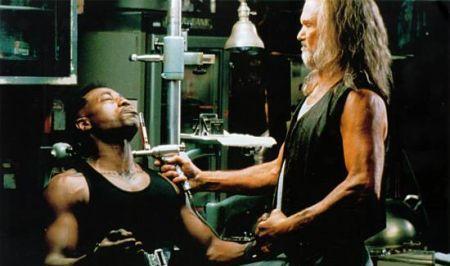 Kris Kristofferson as Whistler, Blade’s limping, unshaven mentor and right hand guy behind the guy is great, delivering macho lines like “Catch you fuckers at a bad time?” in this great Harley ridin’ gravelly growl that I love to imitate (and am only capable of aping) when I’m struck with a chest cold. He spends most of the movie like a frowning old spider in the center of this sparking machine shop web of workbenches and toolkits, metal shelving and jury rigged weaponry. Yet there are cool moments between him and Blade that elevate him above a hollow stereotype. There’s an unspoken fatherliness and mutual respect, when he injects Blade with his serum and grips his hand as he convulses, yet looks away, allowing Blade his dignity. And when Frost leaves Whistler a bloody, dying mess, Blade betrays no emotion, yet mops at the copious blood bootlessly and with the tenderness of a son attending his father’s death bed as Whistler groans his last words.
Kris Kristofferson as Whistler, Blade’s limping, unshaven mentor and right hand guy behind the guy is great, delivering macho lines like “Catch you fuckers at a bad time?” in this great Harley ridin’ gravelly growl that I love to imitate (and am only capable of aping) when I’m struck with a chest cold. He spends most of the movie like a frowning old spider in the center of this sparking machine shop web of workbenches and toolkits, metal shelving and jury rigged weaponry. Yet there are cool moments between him and Blade that elevate him above a hollow stereotype. There’s an unspoken fatherliness and mutual respect, when he injects Blade with his serum and grips his hand as he convulses, yet looks away, allowing Blade his dignity. And when Frost leaves Whistler a bloody, dying mess, Blade betrays no emotion, yet mops at the copious blood bootlessly and with the tenderness of a son attending his father’s death bed as Whistler groans his last words.
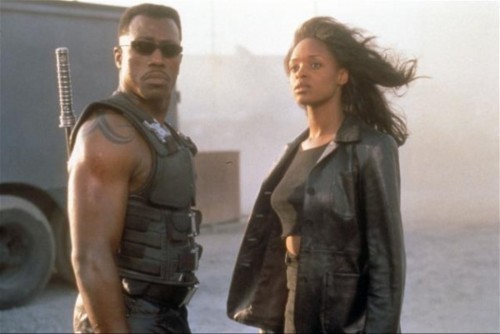 The gorgeous N’Bushe Wright (who I first had a crush on in Zebrahead) provides a little more than eye candy in her portrayal of Dr. Jensen, who is early on bitten by the vampire Quinn and nursed back from the edge of turning by a combination of Blade and Whistler and her own ingenuity. She’s a cool, nominally romantic foil to Blade, doesn’t really swoon overly, and gets herself out of a jam now and then, dispatching the wonderfully otherworldly and decadent Mercury (Arly Jover). She even provides Blade with the impetus to beat the bad guys in the end, offering her own blood. There is some weird Oedipal stuff going on, admittedly. When Blade first decides to try and save her, she is interposed with a shot of Blade’s mother (the stunning Sanaa Lathan) reaching out to him from the delivery room table, and Jensen’s offering of blood and Blade’s ravenous partaking is almost filmed psychosexually. He thrusts his hungry mouth at her, devouring her, and it almost looks like breastfeeding gone horribly wrong. Her interplay with her ex-boyfriend Webb (Tim Guinee) is great, and I absolutely love the abrupt tonal shift when Webb is attacked by the burned to a crisp and presumed dead Quinn on the autopsy table. It’s very indicative of the film’s tone that as these two characters begin to have a believable romantic tiff and the plot starts to sag a bit into familiar expository territory, suddenly a corpse sits up and takes a bite out of one of them.
The gorgeous N’Bushe Wright (who I first had a crush on in Zebrahead) provides a little more than eye candy in her portrayal of Dr. Jensen, who is early on bitten by the vampire Quinn and nursed back from the edge of turning by a combination of Blade and Whistler and her own ingenuity. She’s a cool, nominally romantic foil to Blade, doesn’t really swoon overly, and gets herself out of a jam now and then, dispatching the wonderfully otherworldly and decadent Mercury (Arly Jover). She even provides Blade with the impetus to beat the bad guys in the end, offering her own blood. There is some weird Oedipal stuff going on, admittedly. When Blade first decides to try and save her, she is interposed with a shot of Blade’s mother (the stunning Sanaa Lathan) reaching out to him from the delivery room table, and Jensen’s offering of blood and Blade’s ravenous partaking is almost filmed psychosexually. He thrusts his hungry mouth at her, devouring her, and it almost looks like breastfeeding gone horribly wrong. Her interplay with her ex-boyfriend Webb (Tim Guinee) is great, and I absolutely love the abrupt tonal shift when Webb is attacked by the burned to a crisp and presumed dead Quinn on the autopsy table. It’s very indicative of the film’s tone that as these two characters begin to have a believable romantic tiff and the plot starts to sag a bit into familiar expository territory, suddenly a corpse sits up and takes a bite out of one of them.
 Stephen Dorff’s antagonist Deacon Frost is a cool counterpoint in physicality and attitude to Blade. He looks like some posing clubgoer, and even the vampire elders dismiss him (gotta mention Udo Kier and Judson – Joaquin from Star Trek II – Scott appear as old money purebloods). He talks a lotta smack and appears to party a lot, but in fact he’s got this cold, reptilian demeanor that betrays his ambition. As his minions cavort and dance, he’s shown obsessing over the computer translation of the vampire bible, burning the candle at both ends. Stephen Dorff has nothing on Wesley Snipes in terms of physique, but he’s still deadly in the climactic duel, and when he’s infused with La Magra it’s like watching a cobra and a mongoose go at it. Though he walks around in the daylight under heavy skin crème and looks like something out of Twilight, make no mistake, Frost is totally gangster, proving his monsterhood in a cool scene when he executes Udo Kier with the dawn and tosses his fangs on the board room table to make his point to the rest of the elders.
Stephen Dorff’s antagonist Deacon Frost is a cool counterpoint in physicality and attitude to Blade. He looks like some posing clubgoer, and even the vampire elders dismiss him (gotta mention Udo Kier and Judson – Joaquin from Star Trek II – Scott appear as old money purebloods). He talks a lotta smack and appears to party a lot, but in fact he’s got this cold, reptilian demeanor that betrays his ambition. As his minions cavort and dance, he’s shown obsessing over the computer translation of the vampire bible, burning the candle at both ends. Stephen Dorff has nothing on Wesley Snipes in terms of physique, but he’s still deadly in the climactic duel, and when he’s infused with La Magra it’s like watching a cobra and a mongoose go at it. Though he walks around in the daylight under heavy skin crème and looks like something out of Twilight, make no mistake, Frost is totally gangster, proving his monsterhood in a cool scene when he executes Udo Kier with the dawn and tosses his fangs on the board room table to make his point to the rest of the elders.
 I already mentioned Arly Jover. Mercury’s a white clad skinny as a rail vampire with an untraceable accent, vaguely eastern European, vaguely Irish, and comes across as a White Queen on heroin, visually fascinating to watch and scary as hell. I maintain that more comic actors should be cast as villains, because Donal Togue’s Quinn is a great character. He loves being a vampire, but is a bon vivant and a coattail rider. He and Dorf have their own brand of fun, ad-libbing some great exchanges like “I’m gonna be naughty. I’m gonna be a naughty vampire god.” And that whole bit where Frost pretends he’s going to cut off Quinn’s hand. Clearly Quinn amuses Frost, as I can’t see why else he’d be allowed to stick around.
I already mentioned Arly Jover. Mercury’s a white clad skinny as a rail vampire with an untraceable accent, vaguely eastern European, vaguely Irish, and comes across as a White Queen on heroin, visually fascinating to watch and scary as hell. I maintain that more comic actors should be cast as villains, because Donal Togue’s Quinn is a great character. He loves being a vampire, but is a bon vivant and a coattail rider. He and Dorf have their own brand of fun, ad-libbing some great exchanges like “I’m gonna be naughty. I’m gonna be a naughty vampire god.” And that whole bit where Frost pretends he’s going to cut off Quinn’s hand. Clearly Quinn amuses Frost, as I can’t see why else he’d be allowed to stick around.
The soundtrack for Blade was a big hit, if I remember, the blazing hip hop and electronica complimenting the crazily stylized story perfectly. Particular standouts for me were the opening number, heard in the trailers, the Japanese schoolgirl rap at the vampire club, and that end track that kicks in after Blade catches the sunglasses. It gives the furious action a video game feel that gets me grinning. I also like the simple pulsing track that plays when Blade and Jensen trail Officer Krieger (Kevin Patrick Walls) through the night time streets in their cars, a sequence Norrington shoots in fast motion, lending it a cool, nightmarish quality.
Best Dialogue/Line:
“Some motherfucker’s always tryin’ to ice skate uphill.”
Best Scene:
 The initial scene, the one that pulls you right into the world of Blade. A dopey clubgoer (Elliot James) rides in a hot car with an even hotter chick (Traci Lords), who takes him (and the audience) to this super secret club located behind a meat packing company (were those bodies in the plastic?). She throws the dork her coat and leaves him standing there, and he drops it and tries to get in on the party, but the beautiful but slightly weird dancers reject him at every turn and eye him with all the disdain of a bunch of Hamptonites whose party’s just been crashed by ‘Ol Dirty Bastard. He wanders through the strobing lights, ogling the dancing bodies and finally reunites with his ride, who is dancing seductively with Mercury. When he tries to cut in, he’s shoved away.
The initial scene, the one that pulls you right into the world of Blade. A dopey clubgoer (Elliot James) rides in a hot car with an even hotter chick (Traci Lords), who takes him (and the audience) to this super secret club located behind a meat packing company (were those bodies in the plastic?). She throws the dork her coat and leaves him standing there, and he drops it and tries to get in on the party, but the beautiful but slightly weird dancers reject him at every turn and eye him with all the disdain of a bunch of Hamptonites whose party’s just been crashed by ‘Ol Dirty Bastard. He wanders through the strobing lights, ogling the dancing bodies and finally reunites with his ride, who is dancing seductively with Mercury. When he tries to cut in, he’s shoved away.
This sucks he thinks, and as the music reaches a fever pitch, he mutters something about needing a drink. Suddenly the house lights go up, the DJ roars in front of a banner reading BLOODBATH! and after wiping a spot of red from his cheek, the guy looks up in time to see the overhead emergency sprinklers douse the crowd and him in human blood.
Horrified, he recoils, desperate to find the exit, and each of the partiers starts popping fangs and vamping out. Stumbling away from horrors at every turn, he tries to run, but is laid out by a punch from some shirtless vampire and falls to the bloodsoaked floor, where he’s kicked and pummeled. The sprinklers drained, the music dies down and the crowd applauds and cheers, some holding up bottles to catch the drippings. Slipping to get away, the one lone human crawls towards some clean whiteness, an abbatoir shower or something for the slaughterers, and a big black boot comes into frame.
 He looks up, and the entire crowd of suckheads crouches like wary dogs and backpedals, parting to reveal Blade standing motionless, uncaring of the crimson painted vampires creeping out of his wake, and only nominally concerned by the crowd of the undead milling behind him (“It’s him!” “Daywalker!”).
He looks up, and the entire crowd of suckheads crouches like wary dogs and backpedals, parting to reveal Blade standing motionless, uncaring of the crimson painted vampires creeping out of his wake, and only nominally concerned by the crowd of the undead milling behind him (“It’s him!” “Daywalker!”).
Blade waits for the inevitable as the music reaches a lull.
But as if on cue, when it starts back up again, somebody kicks it off, rushing forward, and what follows is a frantic one against many battle that perfectly introduces the character of Blade. His fearlessness, his weaponry, his attitude.
If you can watch this scene and want to turn this movie off, yeah, it’s not for you.
Would I Buy It Again?
Yes. But you won’t see the other Blade movies on here, unfortunately. Blade 2 couldn’t touch this movie with its screechy Predator-faced vamps, and besides Ryan Reynolds’ creative cursing in Blade Trinity, it’s a snoozer.
Next In The Queue: The Blind Swordsman: Zatoichi


May 5, 2013
AFTER DEATH Signing At Dark Delicacies In Burbank Today
Read about the book here.


May 2, 2013
DT Moviehouse Review: The Black Swan
Time once more for my blog feature, DT Moviehouse Reviews, in which I make my way alphabetically through my 200+ DVD/Blu-Ray collection (you can see the list right here ) and decide if each one was worth the money. Today I review The Black Swan.
(1942) Directed by Henry King
Screenplay by Ben Hecht and Seton Miller, adapted from Rafael Sabatini
Tagline:
When villainy wore a sash and waved a cutlass!
What It’s About:
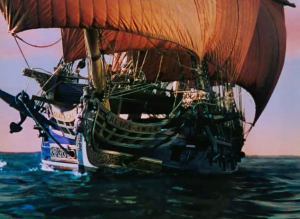 When notorious pirate Henry Morgan (Laird Cregar) receives a full pardon from the king of England and assumes the governorship of Jamaica, he calls upon his former brother captains to set aside their piratical ways and take up the sword for king and country, to once and for all put an end to the rampant piracy of the Spanish Main. Dashing but rogueish Captain Jamie Waring (Tyrone Power) and his first mate Tom Blue (Thomas Mitchell) throw in with Morgan, but unrepentant Captain Leech (an absolutely unrecognizable George Sanders) and Wogan (Anthony Quinn) refuse and set sail for Tortuga to raise hell. Caught between the distrust of the snobbish Jamaican nobility and that of his own former comrades, Morgan’s troubles are compounded when mercenary English gentleman Roger Ingram (Edward Ashley) turns spy for the pirates and undermines Morgan and Waring at every turn. Jamie and Tom take it upon themselves to get to the bottom of things and crush the brutish Leech, but not without romancing Ingram’s hot tempered fiancée the Lady Margaret (Maureen O’Hara).
When notorious pirate Henry Morgan (Laird Cregar) receives a full pardon from the king of England and assumes the governorship of Jamaica, he calls upon his former brother captains to set aside their piratical ways and take up the sword for king and country, to once and for all put an end to the rampant piracy of the Spanish Main. Dashing but rogueish Captain Jamie Waring (Tyrone Power) and his first mate Tom Blue (Thomas Mitchell) throw in with Morgan, but unrepentant Captain Leech (an absolutely unrecognizable George Sanders) and Wogan (Anthony Quinn) refuse and set sail for Tortuga to raise hell. Caught between the distrust of the snobbish Jamaican nobility and that of his own former comrades, Morgan’s troubles are compounded when mercenary English gentleman Roger Ingram (Edward Ashley) turns spy for the pirates and undermines Morgan and Waring at every turn. Jamie and Tom take it upon themselves to get to the bottom of things and crush the brutish Leech, but not without romancing Ingram’s hot tempered fiancée the Lady Margaret (Maureen O’Hara).
Why I Bought It:
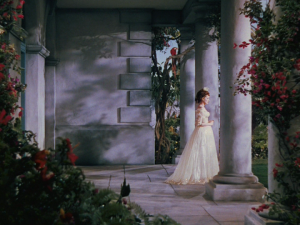
Look at that composition!
There are a handful of positively indispensable classics of the pirate movie genre. Three are based on novels by the adventure writer Rafael Sabatini and The Black Swan is the only one that doesn’t have Errol Flynn in it. This is also probably one of Tyrone Power’s best performances, only slightly behind The Mark Of Zorro.
The first thing you notice about The Black Swan is how lush and beautiful the colors are. I’ve got to call attention to the work of four-time Academy Award Winning (nominated 14 times!) cinematographer Leon Shamroy, who shot the very first Cinemascope picture (The Robe) and was the first black and white cinematographer to win an Oscar for a color film – with this movie. Very well deserved.
Watching The Black Swan in HD (TV – it’s not on Blu-ray) the details and colors just pop out at you. The orange of George Sanders’ beard is like mad, rolling hellfire, and the black and scarlet sash costume of Power is suitably heroic, going nicely with the glow of the smoldering Maureen O’Hara’s skin. Don’t even get me started on those billowing sails and Caribbean sunsets glowing on the waves. This is just a beautiful looking picture.
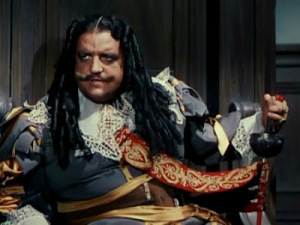
Sir Henry Morgan
The Black Swan teems with great, larger than life characters and big, swaggering performances. Pushing three hundred pounds, Laird Cregar’s Henry Morgan is literally the biggest of these. He’s like an immense bear rearing up on his hind legs. When I think of him, I think of his broad leather belt strapped across his ample belly, huge fists set squarely on either side. In one scene he strides into a tavern at and backhands some drunk across the room, roaring, “FETCH ME A DRINK BEFORE I BLOW AWAY TO DUST!”
Cregar plays him much as the real man might’ve been, a lusty, temperamental barbarian more at home drubbing a swab with a belaying pin than squeezing into ruffles and lace (and his chair of office!) and facing down a gaggle of petitioners in his role as governor. His interactions with the elite of Port Royale are hilarious, and he commands the attention whenever he’s on screen – so much so that I open talking about the movie with him rather than the lead!
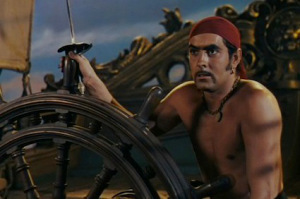 That’s not to say Power’s Jamie Waring is a slouch. He’s dashing and deadly-quick, charming (to a point) and smart, but with a decidedly dark piratical edge that you never quite believe in Errol Flynn’s earnest Captain Blood (even though the real Flynn was probably more of a pirate than Power ever was). Jamie is a cruel sonofabitch, more than I remembered him being when I first saw this picture years ago. He punctuates his first meeting with Maureen O’Hara by trying to rape her and smacking her unconscious when she fights back. No doubt he’s a brute and a villain when we first meet him, and his growing, tender hearted affections for Lady Margaret obviously vex him. Even though he dresses up well, he’s no gentleman, and despises the very word. He’s impulsive and misanthropic as a Robert E. Howard character, flinging Tom Blue and his hefty girlfriend out on their ears when he catches them in bed, calling her a sow, and bullying Lady Margaret’s fiancée Ingram into a duel in which he easily disarms the man and then lays him out with one punch. Yet Jamie is ultimately not as much a slave to his baser passions as he first appears (it could be argued that since Lady Margaret’s father Don Miguel was torturing him on a rack in the opening scene, his initial assault on her was a kind of angry, albeit sexual and of course unconscionable, revenge), and really is trying to be civilized like Morgan (not the greatest role model to begin with). He does his best to fumblingly court Lady Margaret when he makes up his mind that he loves her, although he can’t seem to understand that his attentions are unwanted, even when she bashes him in the skull with a rock.
That’s not to say Power’s Jamie Waring is a slouch. He’s dashing and deadly-quick, charming (to a point) and smart, but with a decidedly dark piratical edge that you never quite believe in Errol Flynn’s earnest Captain Blood (even though the real Flynn was probably more of a pirate than Power ever was). Jamie is a cruel sonofabitch, more than I remembered him being when I first saw this picture years ago. He punctuates his first meeting with Maureen O’Hara by trying to rape her and smacking her unconscious when she fights back. No doubt he’s a brute and a villain when we first meet him, and his growing, tender hearted affections for Lady Margaret obviously vex him. Even though he dresses up well, he’s no gentleman, and despises the very word. He’s impulsive and misanthropic as a Robert E. Howard character, flinging Tom Blue and his hefty girlfriend out on their ears when he catches them in bed, calling her a sow, and bullying Lady Margaret’s fiancée Ingram into a duel in which he easily disarms the man and then lays him out with one punch. Yet Jamie is ultimately not as much a slave to his baser passions as he first appears (it could be argued that since Lady Margaret’s father Don Miguel was torturing him on a rack in the opening scene, his initial assault on her was a kind of angry, albeit sexual and of course unconscionable, revenge), and really is trying to be civilized like Morgan (not the greatest role model to begin with). He does his best to fumblingly court Lady Margaret when he makes up his mind that he loves her, although he can’t seem to understand that his attentions are unwanted, even when she bashes him in the skull with a rock.
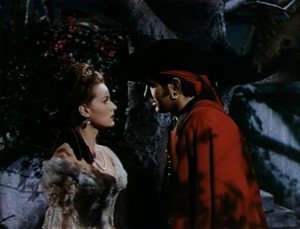 Luckily for him that, as in all mens’ adventure fiction, it turns out that Jamie’s gut instincts are true. Lady Margaret does love him back, and foppish Ingram is a bigger bastard than he is (selling out his country to the pirates for wealth). It’s mainly the exposure of Ingram’s cowardice and treachery that wins her over in the end, I suppose.
Luckily for him that, as in all mens’ adventure fiction, it turns out that Jamie’s gut instincts are true. Lady Margaret does love him back, and foppish Ingram is a bigger bastard than he is (selling out his country to the pirates for wealth). It’s mainly the exposure of Ingram’s cowardice and treachery that wins her over in the end, I suppose.
Now how does a guy like Jamie Waring make an effective good guy? By comparing him to George Sanders’ cunning, brutish Captain Billy Leech. I’ve been a fan of this movie for at least twenty years but I swear, until I prepared to write this review, I never once made the connection that this was the same George Sanders of Village Of The Damned and A Shot In The Dark, that urbane, reserved English gent with the heavy, cultured, velvet lined voice that menaced Mowgli as Shere Khan in Disney’s The Jungle Book.
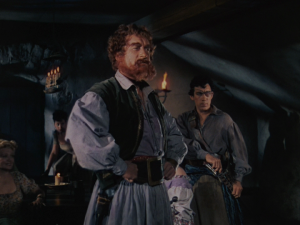 Billy Leech is no gentleman, and makes no pretense of it. He rejects Morgan’s offer outright, preferring bloodshed, rape, and pillaging to respectability any day of the week. But he’s no swashbuckler, no dashing popinjay like say, Basil Rathbone’s Levasseur, trying to match Jamie for charm. He’s an ill-tempered Viking on a pirate ship, repulsive with his thick, unkempt hair and bushy orange eyebrows. You can barely see his lips move behind all that facial hair, and everything he says sounds like a mumbled threat. He’s not in the piracy game for the fun either. When he’s shown drinking it up with his crew in a tavern, he smashes a jug of ale against a subordinate’s head, sending him to the floor bleeding from his ear for the wench he wants, whom he then drags off without a word as she giggles shrilly.
Billy Leech is no gentleman, and makes no pretense of it. He rejects Morgan’s offer outright, preferring bloodshed, rape, and pillaging to respectability any day of the week. But he’s no swashbuckler, no dashing popinjay like say, Basil Rathbone’s Levasseur, trying to match Jamie for charm. He’s an ill-tempered Viking on a pirate ship, repulsive with his thick, unkempt hair and bushy orange eyebrows. You can barely see his lips move behind all that facial hair, and everything he says sounds like a mumbled threat. He’s not in the piracy game for the fun either. When he’s shown drinking it up with his crew in a tavern, he smashes a jug of ale against a subordinate’s head, sending him to the floor bleeding from his ear for the wench he wants, whom he then drags off without a word as she giggles shrilly.
This guy is a real cutthroat, and in a later scene when he pretends to be drunk and laughs to figure out Jamie’s plans, it’s the only time Sanders doesn’t come across as genuine. Because Leech doesn’t laugh at little things like being drunk. You get the sense that killing is his sole amusement, and the end duel between him and Jamie is harrowing and deadly without a trace of flash. Interestingly, it also ends with both men stabbed, Jamie sinking against a bulkhead and Leech staggering out the door to his own cabin with a sword entirely through his guts, off to go die out from under the eyes of all these goggle eyed lubbers.
Anthony Quinn makes an appearance as Leech’s growling, one-eyed, scarlet eyepatched right hand man, but he doesn’t have much to do other than look tough, whereas his opposite number, Thomas Mitchell (drunken, knot fingered Uncle Billy from It’s A Wonderful Life) outshines him as Tommy Blue, a mostly loveable Mr. Smee kind of fellow, confounded by Jamie’s infatuation with Lady Margaret (“If you kick her in the heart she’ll break your leg, Jamie.”), but always game for a fight.
 Maureen O’Hara is sorely underutilized here. She’s supposed to be her usual spitfire self, but Lady Margaret, like Wogan, just doesn’t have a whole lot to do besides standing around looking good. Her romance with Jamie is the most implausible thing about The Black Swan, and I think as an actress she knows it. It’s a shame because the chemistry between the leads is definitely there, I just think the initial meeting and the subsequent coarseness of Jamie makes it highly improbably that she’d call him Jamie-boy in the end, even though he does save her from Leech.
Maureen O’Hara is sorely underutilized here. She’s supposed to be her usual spitfire self, but Lady Margaret, like Wogan, just doesn’t have a whole lot to do besides standing around looking good. Her romance with Jamie is the most implausible thing about The Black Swan, and I think as an actress she knows it. It’s a shame because the chemistry between the leads is definitely there, I just think the initial meeting and the subsequent coarseness of Jamie makes it highly improbably that she’d call him Jamie-boy in the end, even though he does save her from Leech.
One last gripe I have about this movie is Alfred Newman’s brassy trumpet score. I know the guy won the Academy Award nine times and did some fantastic scores, but the music for The Black Swan kinda grates on me, especially this transition tune he does that sounds like a trumpet player falling down a flight of stairs.
Best Dialogue/Line:
“I always sample a wine before I buy it, m’gal.”
Best Scene:
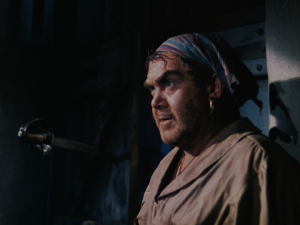 The end fight on board Leech’s ship The Black Swan is fantastic, but leading up to it there’s a little bit I like where Jamie’s crew has been captured and locked in the hold.
The end fight on board Leech’s ship The Black Swan is fantastic, but leading up to it there’s a little bit I like where Jamie’s crew has been captured and locked in the hold.
One of Leech’s sailors sits on the cargo hold grating and Tommy Blue pulls out a dagger.
“You may lock me in a hole, you varmints, but you can’t sit on me. Here’s to you. Bottoms up!”
He jabs the pirate in the ass.
The guy jumps up and shakes his fist at them, cursing, and douses them with a bucket of deck water.
Tommy and the sailors, still grinning and looking up through the hold, don’t even blink.
Would I Buy It Again?
Yes. Despite its flawed, somewhat misogynistic love story, the action and cinematography are solid and the main roles are suitably swashbuckling. This is one of those pirate movies that forms the well from which all subsequent outings in the genre have to dip.
Next In The Queue: Blade


April 29, 2013
Atomic Interviews #9
Mark Bousquet’s Atomic Interviews #9 features me talking about Merkabah Rider and The Van Helsing Papers. Give it a read here -


April 26, 2013
An Afternoon of Horror at the Pasadena Central Library
Tomorrow from 1PM-5PM I’ll be at the Pasadena Central Library as part of their Afternoon of Horror with the HWA.
I’ll be on the How To Get Started Writing And Publishing In The Horror Industry panel with Stoker nominated moderator John Palisano, PS Gifford, and Eric Miller, editor of the Stoker nominated anthology Hell Comes To Hollywood.
After the panel I’ll be selling and autographing books in the courtyard, so stop on by.
Other panels include Recommended Horror Reading with Brad C. Hodson, Hal Bodner, Ted E. Grau, and Stoker award winning author Benjamin Kane Ethridge, and Horror For Young Adults, with Lisa Morton, Roh Morgan, E.S. Magill, and Kelly Dunn.
More info here -
http://www.ci.pasadena.ca.us/EkContent.aspx?theme=Olive&id=8589937351&bid=0&style=news



